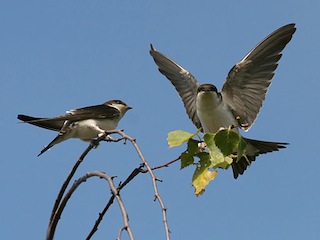 House Martins arrive back in the UK in the spring.
House Martins arrive back in the UK in the spring.
Photo: Ken Billington
Scientific name: Delichon urbicum (synonym: Delichon urbica)
Other common names: Common House Martin, Northern House Martin
Cornish name: Chikog
Conservation status: UK Birds of Conservation Concern, Amber; IUCN Red List, Least Concern; Species of European Concern.
What to look for:
- Colouring and appearance: Snowy white underneath contrasting with the glossy blue-black of its back and wings. Forked tail with white rump.
- Size: Length 12 cm, wingspan 28 cm.
- Where: Summer visitor, across most of the UK although much more scarce in the far north. Usually associated with grassland, woodland edge and meadow habitats where its insect prey is more abundant.
- Call: High-pitched trill
- Similar species: Barn Swallow, Sand Martin, Swift.
 You know spring is in the air when the first House Martins return here from their African winter homes. They arrive as the colder early days of spring make way for the warmer days of April, swooping and winging their way through the air as they hunt their insect prey.
You know spring is in the air when the first House Martins return here from their African winter homes. They arrive as the colder early days of spring make way for the warmer days of April, swooping and winging their way through the air as they hunt their insect prey.
Summer visitors to the UK, House Martins come here to breed. They live in proximity to us humans, building their cup-shaped mud nests in the eaves of buildings, generally in colonies. In fact, House Martins are much more ‘urban’ than Swallows, which return to our shores at the same time, often nesting right in the middle of cities. The behaviour of nesting on buildings is an adaptation, first becoming common in the early nineteenth century, from the House Martin’s origins as a cliff- and cave-breeder.
Both the male and female bird of a pair share in nest building, collecting mud in small pellets in order to gradually piece it together stoically over a period of up to ten days, and then lining it with grass and hair. Unlike Swallows, they build their nests on the outside of buildings. A pair can produce two broods (sometimes three) in a year of four to five eggs each, reusing the same nest.
Did you know…?
…’Free love’: a House Martin pair breeds together for life, but both male and female also copulate with other birds.
…’Nest wars’: House Sparrows often try to take over House Martin nests. If they succeed, the House Martin pair just goes away and builds another one.
More information and references:
Svensson, L., Mullarney, K., Zetterstrom, D.,1986. Collins Bird Guide, second edition (translated by Christie, D., Svensson, L.). HarperCollins, London.
Published: March 2015
Author: Amanda Scott
Photo: Ken Billington [CC BY-SA 3.0]
